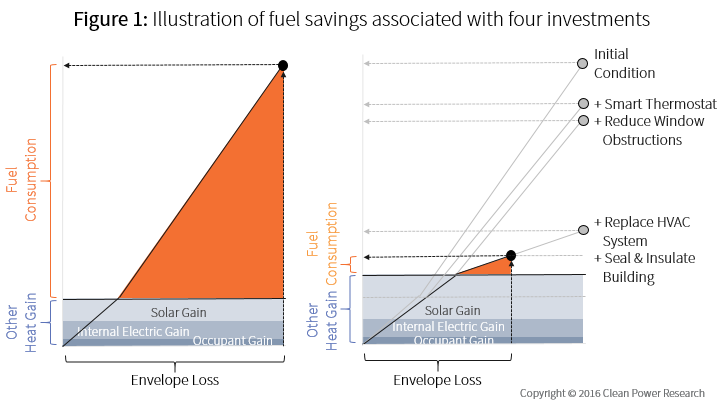This is the seventh article of an 11-part series on Solar+ homes. The series describes how homeowners can combine simple energy efficiency measures, solar PV, electric vehicles and appliance electrification to create households that are fully powered by solar electricity—even in existing homes. A Solar+ home provides substantial economic and environmental savings to the homeowner, and creates load profiles that are low-cost for utilities to serve.
Why wait to discuss building shell improvements?
Conversations about energy efficiency elicit images of caulking and weather-stripping in many people’s minds. This blog series, however, initially focused on basic electrical efficiency and fuel switching. There are several reasons for this approach:
- Evaluating building energy investments is complicated because there are many options, including: smart thermostats; new windows; insulation; caulking; weather sealing; various types of heating, ventilating and air conditioning (HVAC) equipment; etc.
- The widely-used heating and cooling degree day approaches make it challenging to isolate the effect of different types of investments.
- Home-heating in moderate climates such as California consumes less energy than vehicles, and is comparable to water heating energy consumption.
- Heating and cooling needs should be treated differently from an analytical perspective.
Energy balance approach
It’s useful to take an energy balance approach to evaluate building energy consumption. A building is in balance if indoor temperatures at the beginning and ending of the time period are the same. As one can imagine, it’s simple to satisfy this condition, particularly when the analysis is performed over a season. An energy balance is achieved by setting heat gain equal to heat loss. The additional parameter that describes comfort is the average temperature over the time period.
A building’s indoor temperature changes based on the amount of heat gained or lost and the building’s thermal mass. Only three sources provide heat gain (occupancy, internal electric and solar), and two sources provide either heat gain or heat loss, depending on the season (HVAC and envelope).
Occupancy is the heat given off by people. Internal electric is the heat given off by devices such as lights and TVs. Solar is the heat gained due to the sun through windows and the sun’s heating of exterior building surfaces.
HVAC is a gain in the winter when the heater is operated, and envelope is a gain in the summer when it’s warmer outside than inside. HVAC is a loss in the summer when the air conditioner (A/C) is operated, and envelope is a loss in the winter when it’s colder outside than inside. Envelope loss can also occur in the summer when it’s colder outside than inside at night.
The energy balance approach in the winter requires that heat gain—which is the sum of occupancy, internal electric, solar and HVAC (heater) gains—equals envelope heat loss. The energy balance approach in the summer requires that heat gain—which is the sum of occupancy, internal electric, solar and envelope gains—equals heat extracted by the HVAC system (A/C). HVAC fuel requirements are calculated by incorporating HVAC efficiency (or coefficient of performance for A/C or heat pumps).
The energy balance approach can be used to assess the effect of investments on fuel consumption. Investment effects depend upon the initial situation of the building. Buildings are challenging in that the needs can differ significantly between various buildings. Once a building has been quantified, however, investments can be evaluated. A subsequent blog will describe how to use Virtual and Lean Energy Audits to quantify the initial situation.
Heating investment analysis
Consider an application of the energy balance approach in the winter. Figure 1 assesses the combined effect of four possible investments/actions. The investments/actions include:
- A smart thermostat that will save fuel by reducing average indoor temperature.
- Reduction of window obstructions such as trimming trees and removing window screens in order to increase solar gain.
- Replacing the natural gas HVAC system with an electric mini-split heat pump in order to improve overall HVAC system efficiency.
- Sealing and insulating the building to reduce air and heat leakage.
The blue areas of the graphs in Figure 1 correspond to heat gain from occupancy, internal electric and solar gains. The orange area corresponds to HVAC fuel consumption. The x-axis relates heat gain to envelope loss. HVAC fuel consumption is plotted versus envelope loss.
The left side of Figure 1 is the initial condition, and the right side is the result after all investments. The right side of the figure illustrates how each investment/action changes HVAC fuel consumption including the interaction between the various investments. The figure shows that investments can be combined in such a way as to substantially reduce heating fuel consumption.

Key takeaway
A building thermal analysis can be simplified by taking an energy balance approach. The result provides clarity to non-energy experts. The benefit is that a variety of investments can be evaluated, including their interacting effects. Energy consumption can be greatly reduced when combinations are intelligently selected.
Don’t miss the next article in the series! Subscribe now to receive future updates about Solar+ homes.
To go to the next article in the Solar+ homes series, click here.
To go to the previous article, click here.
To jump to the first article in the series, click here.
